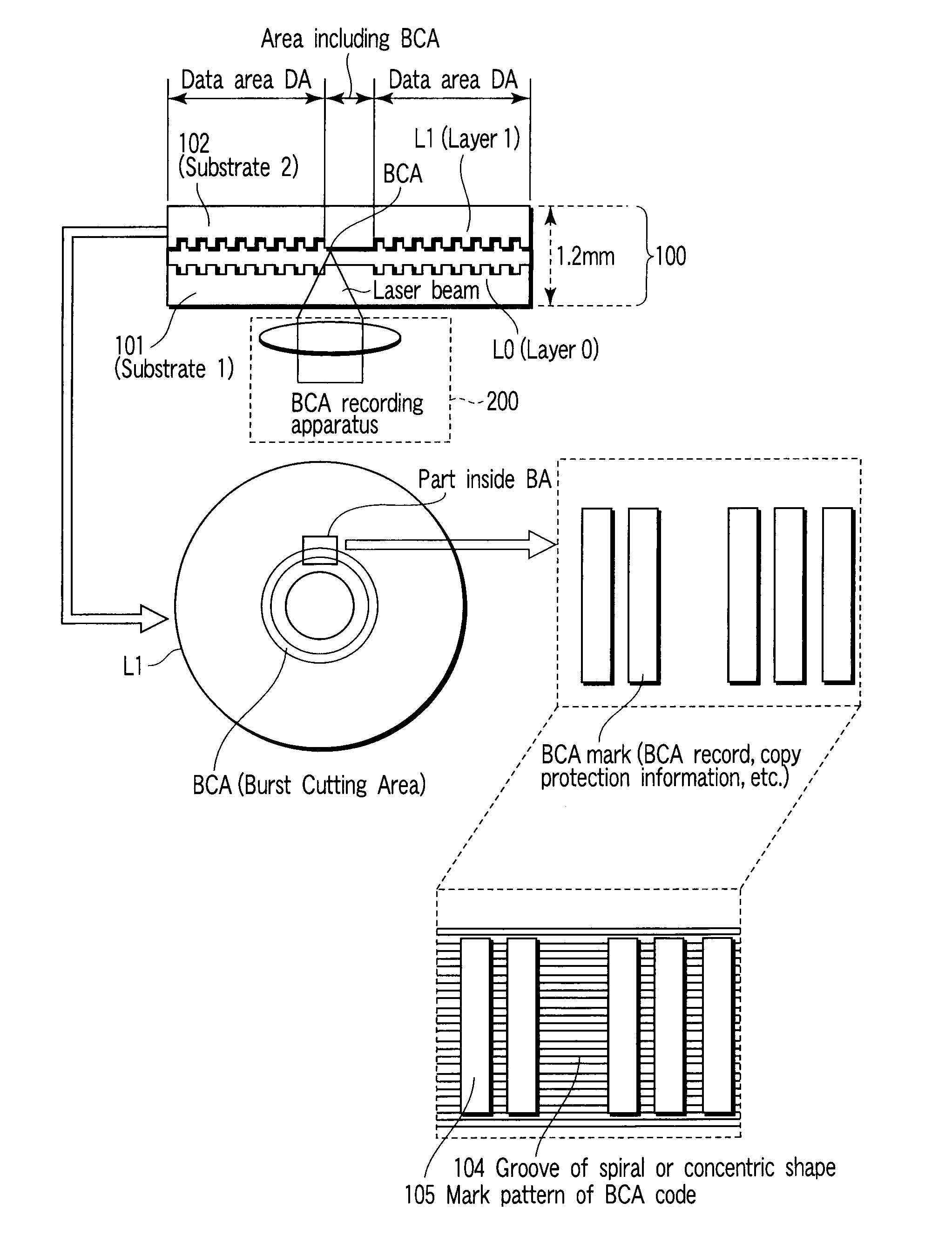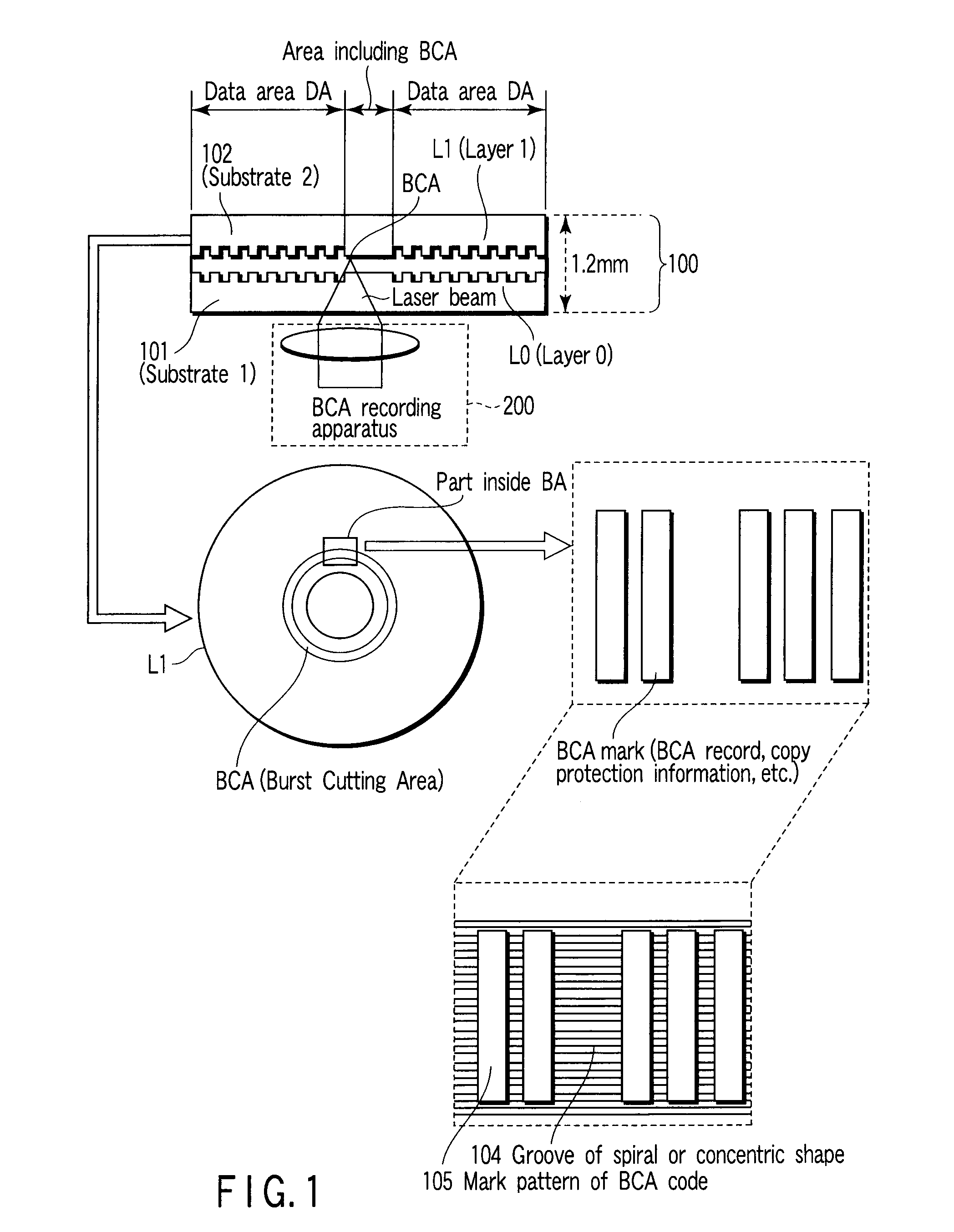Optical disc, information recording method, information reproducing method, and disc drive
- Summary
- Abstract
- Description
- Claims
- Application Information
AI Technical Summary
Benefits of technology
Problems solved by technology
Method used
Image
Examples
example 2
[0079] In the disc of Example 1 described with reference to FIG. 1 and the like, the dye thickness is earned by the effect of groove 104 which is formed in advance (in other words, the volume of the dye which absorbs the energy of a laser in unit time increases), thus increasing the recording sensitivity upon BCA formation. However, in addition, adjusting an organic dye component used in the layer on which the BCA is to be formed is also an effective method in terms of improvement of the recording sensitivity upon BCA formation. That is, for example, in a dual-layer HD_DVD-R disc, since the BCA is formed only on the L1 layer, the organic dye of the L1 layer is adjusted.
[0080] A pre-production disc of Example 2 is prepared under the following conditions. After an L0 layer using a recordable organic dye which had an absorption near 405 nm is formed, an L1 substrate pattern is transcribed or transferred on the L0 layer using a photopolymer, and an L1 organic dye is further applied by ...
example 3
[0082] The write-once, dual-layer discs pre-produced by the methods of Examples 1 and 2 underwent BCA part signal evaluation. An evaluation apparatus is an optical disc evaluator having an optical head which has laser wavelength λ: 405 nm and numerical aperture NA: 0.65 of an objective lens of an optical pickup. The arrangement of the evaluation apparatus will be described below.
[0083]FIG. 14 is a schematic block diagram of an optical disc evaluation apparatus according to one embodiment. Optical disc apparatus 20 comprises optical pickup unit (optical head) 21, level slice signal processing circuit 23, PRML signal processing circuit 24, signal determination circuit 25, drive control circuit 26, error correction unit 27, host apparatus interface 28, modulator 29, write compensation circuit 30, write driver 31, servo control unit 32, spindle motor 33, and the like.
[0084] Optical pickup unit 21 has objective lens 12. Optical pickup unit 21 includes semiconductor laser unit 22 in cor...
application examples
OTHER APPLICATION EXAMPLES
[0086] Write-once optical discs include High-to-Low media in which the reflectance of a mark is lower than that of an unrecorded part upon recording, and Low-to-High media in which the reflectance of a mark is higher than that of an unrecorded part (for example, when a dye described in Jpn. Pat. Appln. KOKAI Publication No. 2002-74740 or Jpn. Pat. Appln. KOKAI Publication No. 2002-206061 is used). The embodiment can be applied to both the types of media. Furthermore, the embodiment can be applied to not only a case in which a barcode-like pattern is recorded on the BCA area, but also a BCA pattern in which “unrecorded” parts define a barcode shape like outline characters.
PUM
 Login to View More
Login to View More Abstract
Description
Claims
Application Information
 Login to View More
Login to View More - R&D
- Intellectual Property
- Life Sciences
- Materials
- Tech Scout
- Unparalleled Data Quality
- Higher Quality Content
- 60% Fewer Hallucinations
Browse by: Latest US Patents, China's latest patents, Technical Efficacy Thesaurus, Application Domain, Technology Topic, Popular Technical Reports.
© 2025 PatSnap. All rights reserved.Legal|Privacy policy|Modern Slavery Act Transparency Statement|Sitemap|About US| Contact US: help@patsnap.com



